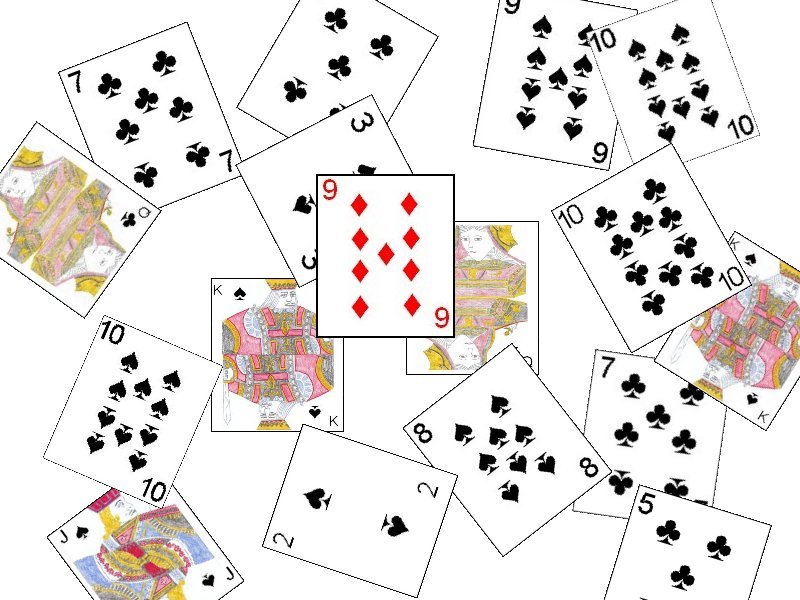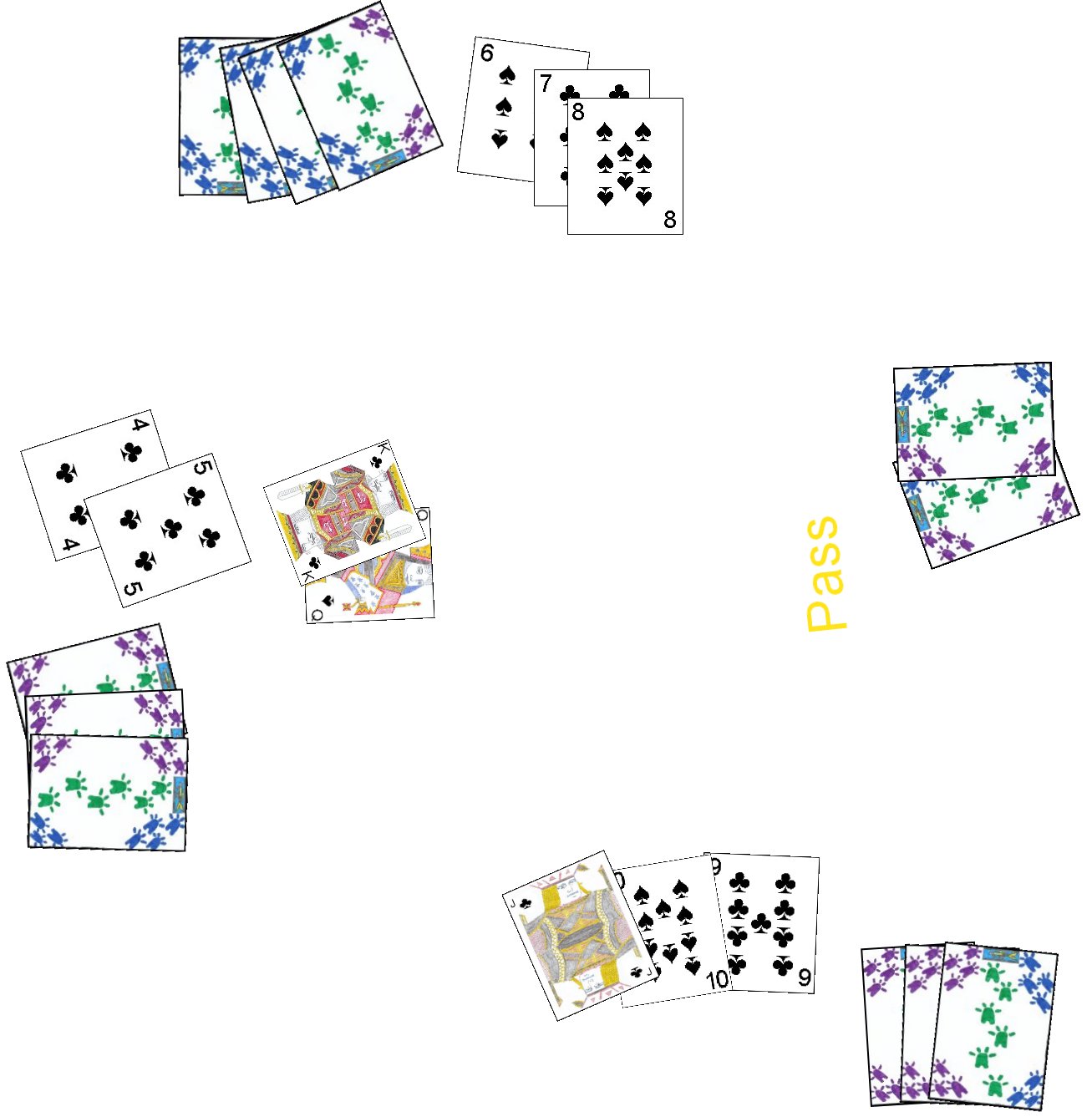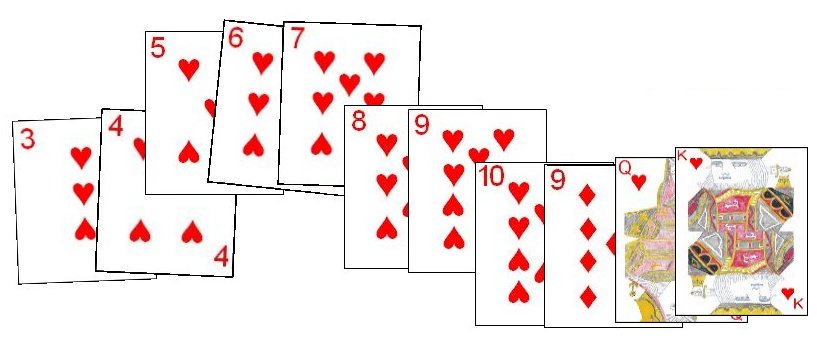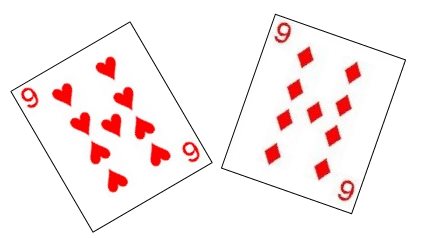
Comet is the oldest in the Stops family of card games that is still
regularly played today. It has been played since the Eighteenth century in which it was said to be quite popular and still makes for a fun game in modern times.
Comet is designed to be played by from two to five players with a special deck that can be constructed from two regular 52 card decks (which should
ideally have the same back design). From a standard deck first remove the four Aces, which are not used in this game. From the same deck, remove all red cards except the
nine of Diamonds. Then, add into this deck all the black cards (excluding Aces) from the second deck except the
nine of Clubs. This should then create a 48 card deck. The ranking of the cards in this special deck, from high to low, is: King, Queen, Jack, 10, 9, 8, 7, 6, 5, 4, 3, 2. The suits are ignored in this game, however the lone red nine is a special card, called the Comet which has special
effects when played.
Although the deck above describes the traditional deck used for this game, the cards not used in constructing the deck above can also be combined (except for the Aces) to create a second Comet deck, with all red cards except the Nine of Clubs which would function as the Comet in this second deck.
Once the deck has been constructed, the deck should be shuffled and each active player draws one card. The player drawing the lowest card becomes the first dealer. After each hand the deal passes in a clockwise rotation from player to player around the table. Before beginning the first deal, an equal number of chips should be distributed to each player (such as 100).
The number of cards dealt to each player is dependent on the number of players in the game. The following chart shows how many cards each player should receive as well as how many cards will be left over to form the Dead Hand.
| Number of Players | Cards Received Per Player | Cards in Dead Hand |
|---|
| 2 | 18 | 12 |
| 3 | 12 | 12 |
| 4 | 10 | 8 |
| 5 | 9 | 3 |
After the requisite number of cards have been dealt to each player, the remaining cards are placed face down in a Dead Hand that will not be used during play.
 |
| A potential sequence played in the game Comet. Each player plays as many cards as he can to continue the sequence. |
The player to the dealer's immediate left has the first turn. This player may play any card of his choice face up to the center of the table. He may continue to play cards from his hand to the center as long as he has the next higher card in the sequence. As he plays each card he should clearly state the denomination of the card being played. Once he can play no more cards, he says "Without" indicating his inability to continue the sequence. At this point, the turn to play would then move to the next player in a clockwise rotation at the table. This next player would then attempt to continue the sequence for as many cards as able. When he has no more plays, like the lead off player, he would also declare "Without", ending his turn. However, if has no cards he can play to continue the sequence at all, he would instead say "Pass" or "None" and the turn would also rotate to the next player. A player able to play on his turn must do so and attempt to continue the sequence as far as able (but is never required to play the Comet unless he opts to). If a player plays the King (the last and highest card in each Sequence), the same player may then start a new sequence with any card in his hand and may continue to build the sequence as able. In addition, if all other players pass after a player declares "Without", the turn returns to the player who last stated "Without" and he can also start a new sequence with any card in his hand. If a player, during his turn has all four cards of the next card in sequence, he may play all four. He may also do this if he holds three nines (not including the Comet).
The Comet: The Comet is a wild card and has special affects on the
game when it is played during a player's turn. A player may play the Comet at any time during his turn in place of any other card (usually replacing a denomination he does not possess). Once played, the individual who played the card may begin a new sequence with any card in his hand. In addition, when the Comet is played, each other player must give the player of the Comet two chips from their own stock. If the Comet is found in the Dead Hand during a round, it's scoring value is increased by two additional chips for the next hand. Thus, for the next hand after a hand in which the Comet was found in the Dead Hand, the player of the Comet would receive 4 chips from each other player. If the Comet did not appear during that hand either, in the next hand it would earn the player 6. Thus, the scoring value for the Comet will increase by 2 for each hand in which it is found to be in the Dead Hand. Once the Comet is played during a hand or found in a player's hand when another player runs out of cards, on the following round its score reverts to the normal score of 2.
Scores and Winning the Game: The object of each hand is to be the first player to run out of cards in his hand. The player first to do so collects a number of chips from each other player dependent on the sum value of specific cards left in that players hand. The following chart shows the scoring value of each card that might remain in a players hand:
| Card | Normal Score (Without Comet in Hand) | Score With Comet in Hand |
|---|
| 2, 3, 4, 5, 6, 7, 8, 9 | Value marked on card | Twice the value marked on card |
| 10, Jack, Queen, King | 10 | 20 |
| Comet | N/A | 18 |
As can be seen from the chart above, if the Comet is found in a player's hand, that player must pay the winner of the hand double for all the cards in his hand. If a player plays the Comet as his last card he also earns double points from each player (as well as four chips immediately from each player for playing the Comet). If he manages to play the Comet as his last card and the card being replaced by the Comet would be an actual nine, he scores quadruple points from each opponent (as well as 8 chips immediately from each player for playing the Comet).
At the end of some set number of hands, the player with the most chips in their possession is declared the game winner.
Opera: In some games, an additional special bonus is added. If the first player to have a turn is able to play his entire hand in one turn, all other players must pay double for each card in their hand. This bonus would be doubled again if the last card played was the Comet and doubled yet again if the Comet was used in place of a nine.
Commit: Although this game is considered an even older version of the standard game, it is the version of the game that is most often encountered today. This version uses a standard 52 card deck with the eight of Diamonds removed. Depending on the number of participants, additional cards may also need to be removed from the deck to allow an even deal (see chart below). As in the standard version, the nine of Diamonds is considered the Comet. This version, is usually played by from 2 to 8 players. In this version no dead hand is dealt, however, specific cards are removed (in addition to the Eight of Diamonds which is always missing) to allow the deck to divide evenly among the players. The following table shows the number of cards dealt to each player as well as additional cards removed from the deck, which is dependent on the number of active participants in the game.
| Number of Players | Cards per Player | Additional Cards Removed |
|---|
| 2 | 25 | One Seven |
| 3 | 17 | None |
| 4 | 12 | Two Sevens and One Eight |
| 5 | 10 | One Seven |
| 6 | 8 | Two Sevens and One Eight |
| 7 | 7 | One Seven and One Eight |
| 8 | 6 | Two Sevens and One Eight |
Once the proper deck size has been created, the dealer distributes the cards to the player in a clockwise rotation around the table one card at a time until each player has the indicated number. The player to the dealer's immediate left has the first turn. He plays the lowest card from his hand of any suit to the center of the table and may continue to play cards as long as they continue an upward sequence and are of the same suit. He should state the denomination of each card as he plays it. Once he is unable to play (not having the next card in sequence of the same suit), he declares Without and the turn moves to the next player in rotation.

On each turn, a player attempts to play as many cards as able to increase the current sequence. Once unable to play such a card, he also must say Without. If unable to play any cards he instead says Pass. In either situation, the turn moves to the next player. If a player is able to play the last card in the sequence (the King) he may then start a new sequence with his lowest card. In addition, he scores 1 point for playing a King. If all other players pass after a player has declared "Without", the player declaring "Without" may also start a sequence playing their lowest card. When starting a new sequence the player is never required to play the Comet even if the Comet is his lowest card.
The Nine of Diamonds (Comet) can be played on a players turn at any time to replace any other card. This earns the player two points. After playing the Comet, the player may either play the card the Comet was set to replace or may play the next card in sequence after the card the Comet was played to replace.
The first player to run out of cards is declared the winner of the hand and scores one point for that accomplishment. In addition, that player scores two points for each King found remaining in each other players hand and one point for every other card found in those hands. If a player is still found with the Comet in their hand, every player except the player whose hand it was found in scores one additional point. The first player to accumulate 100 total points is declared the winner.
 Red Nines
Red Nines: Red Nines is a variant of Commit which is played very similarly to that game. It uses one standard deck of cards and is designed to be played by four players. It can be played by additional players, with the requirement that one full set of cards of one suit added for each additional player participating in the game. For an even number of players, there should be an equal number of black and red suits included. If there is an odd number of players, there should be one more red suit than black suit. The ranking of the cards in the deck, as
the cards are designed to be played in ascending sequences, is as follows (from lowest to highest); Ace, 2, 3, 4, 5, 6, 7, 8, 9, 10, Jack, Queen, King.
To begin, the dealer distributes the entire deck around table
to the players. After the cards have been dealt, play begins with the player to the immediate left of the dealer
having the first turn. This player may then play any card of his choice from his hand
face-up to the center of the table. On this first play of the hand only, the leading player may play as many additional cards of this same rank as he has in his hand. This
special play of these additional cards of that same rank can only be made on the first turn of each hand. After this first play, the
same player may continue to play additional cards in direct sequence, building upwards
(irregardless of the suit of the card) until reaching the rank of King.
As cards are played, the player playing each card should announce the
denomination of the card as he plays it
to the table. If a player manages to play the King of the suit,
completing that sequence, he may then start a new sequence with any rank
of card from his hand. If a player, on his turn does not have the next card in the sequence, he
must pass, and the next player in turn has the opportunity to play, and
that player may continue to play until unable to do so. If the turn
advances to a player who has no legal player, must simply pass, with the
turn then advancing to the next player. The game continues in this manner in a clockwise direction around the table. If it occurs that every player must pass (saying
"No") at the table, the player who made the last legal play may then start a new sequence using any card from his hand.
The red nines (nine of Diamonds
♦ and nine of Hearts
♥) are considered wild cards in this game. These
cards may thus be used to substitute for a card of any other rank and be
played when that rank would be required to be played. It may also be played when an actual nine is required, but a player who has a red nine is never required to play that card and may pass (saying
"No") instead on his turn, saving the nine for another play. When playing a red nine the player should state the card the red nine is replacing to continue the current sequence.
The game continues until one player
manages to legally play his last card. This player is considered the winner
of the hand and earns a score of zero for that hand. Each other player
then earns a number of points based on each card currently found in his hand, as per the following chart:
| Card | Point Value |
|---|
| 2 to 10 | Face value marked on card |
| Jack | 11 |
| Queen | 12 |
| King | 13 |
| Ace | 20 |
If a player is found to have a
red nine remaining in hand, his entire score for that hand is doubled (including the nine points for the red nine itself). If the player has two red nines in his hand, his score for the hand is quadrupled (including
nine points for each red nine). If a player manages to play a red nine as his last card, the scores for all other players is
also doubled.
One game consists of a number of hands equal to the number of players
in the game (to ensure each player has one opportunity to have the first
play in the game). After this number of hands is played, the player with the lowest
total score is considered the overall game winner. After each hand, the deal rotates in clockwise direction around the table.
Copyright © 2015
CatsAtCards.com. All rights reserved.
 Comet is the oldest in the Stops family of card games that is still
regularly played today. It has been played since the Eighteenth century in which it was said to be quite popular and still makes for a fun game in modern times.
Comet is the oldest in the Stops family of card games that is still
regularly played today. It has been played since the Eighteenth century in which it was said to be quite popular and still makes for a fun game in modern times.
 On each turn, a player attempts to play as many cards as able to increase the current sequence. Once unable to play such a card, he also must say Without. If unable to play any cards he instead says Pass. In either situation, the turn moves to the next player. If a player is able to play the last card in the sequence (the King) he may then start a new sequence with his lowest card. In addition, he scores 1 point for playing a King. If all other players pass after a player has declared "Without", the player declaring "Without" may also start a sequence playing their lowest card. When starting a new sequence the player is never required to play the Comet even if the Comet is his lowest card.
On each turn, a player attempts to play as many cards as able to increase the current sequence. Once unable to play such a card, he also must say Without. If unable to play any cards he instead says Pass. In either situation, the turn moves to the next player. If a player is able to play the last card in the sequence (the King) he may then start a new sequence with his lowest card. In addition, he scores 1 point for playing a King. If all other players pass after a player has declared "Without", the player declaring "Without" may also start a sequence playing their lowest card. When starting a new sequence the player is never required to play the Comet even if the Comet is his lowest card.
